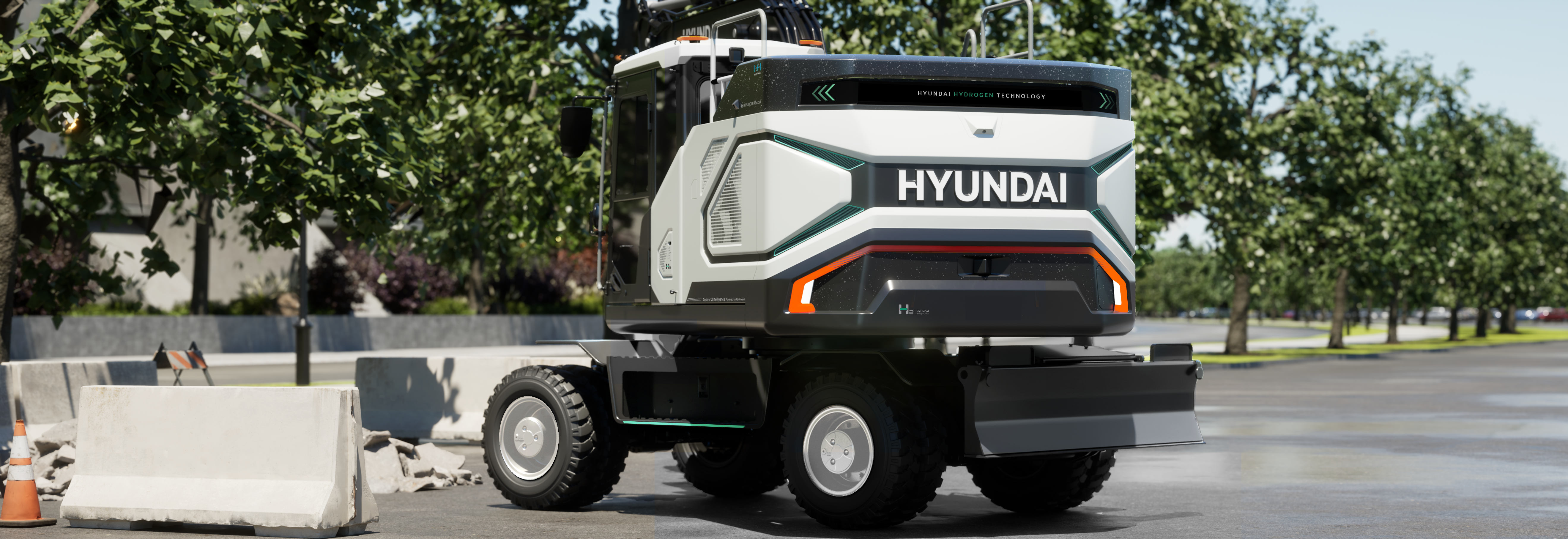Hyundai’s hydrogen fuel-cell prototype is now market-ready and will probably be totally demonstrated at Bauma Munich, setting it as much as turn into a standard-bearer for a development proper throughout the development car trade in direction of this zero-carbon gas
Hyundai Building Tools is to showcase its second-generation HW155H – a hydrogen gas cell-powered wheeled excavator prototype – at Bauma Munich. The primary model of the machine was displayed as a static exhibit at Bauma 2022, however it’s going to now be totally operational within the demonstration space all through the occasion, exhibiting how hydrogen expertise can contribute to emission-free development operations.
The HW155H has developed since its preliminary presentation. “We aren’t speaking a few idea anymore, however we’re prepared for mass manufacturing,” explains Peter Sebold, product supervisor at Hyundai. “Nonetheless, we aren’t launching the machine totally as a result of the market isn’t prepared for us or for hydrogen, by way of infrastructure and so forth.”
The car is powered by gas cells developed in partnership with Hyundai Motor Firm – a 30kW and a 50kW unit. The HW155H combines these to offer 70–100kW of energy, corresponding to a traditional diesel-powered excavator of this dimension. This energy is used to drive electrical motors or electrically-driven hydraulic pumps.
Strong-state of thoughts
Maybe probably the most attention-grabbing improvement within the newest iteration is the hydrogen storage system. “The most important change is the tank system that we now have. It’s now a solid-state tank storage system, which relies on a expertise referred to as steel hydride,” says Sebold. “This expertise has by no means been utilized in development equipment, so it’s a first-time improvement.”
The system works by having a stable construction as a substitute of getting a hole tank. “You must think about it like a sponge that’s absorbing the molecules of the hydrogen in fuel kind which allows extraordinarily excessive density,” says Sebold.
The solid-state storage resolution operates at a considerably decrease stress than standard methods – round 300 bar in comparison with 750 bar – whereas reaching a better storage density. “You really compress the hydrogen, so that you improve the quantity of the tank, which has as a constructive consequence that the machine has extra fill, this implies it has longer autonomy,” says Sebold.
This improved storage capability permits for roughly 12 hours of runtime, with refueling taking simply 10 minutes. “There’s no charging, no batteries. You refill the machine in 10 minutes, like in case you have been filling up your automotive on the fuel station,” says Sebold.

Actually zero-emissions
Whereas hydrogen combustion engines are being developed by some OEMs and have clear benefits by way of counting on established ICE expertise and structure, fuel-cells have a bonus by way of emissions.
“Another corporations are working and growing combustion engines,” says Sebold. “The distinction is, with a combustion engine, it’s not totally zero emission. You don’t have any extra CO2, – that’s eradicated – however you continue to have NOx, so there are nonetheless some emissions. The good factor about utilizing the gas cells is that it’s hydrolysis in reverse, mainly, and so the one emission that you’ve popping out is pure distilled water.”
Future pondering
The second-generation HW155H fuel-cell excavator has gained the eye of Bauma’s organisers, as confirmed by its nomination for Bauma 2025’s Innovation Awards within the Local weather Safety class. Because the truthful in Munich will get underway Sebold anticipates important curiosity from trade professionals: “It’s going to be attention-grabbing and thrilling to see the reactions from the general public, prospects, contractors. I’m certain we’ll get requests to get the machine for testing functions in some job websites.”
As development corporations face growing stress to scale back their environmental affect, hydrogen energy might symbolize a viable resolution for reaching sustainable operations whereas sustaining the efficiency ranges required in demanding development environments.
This text first appeared within the March situation of iVT


